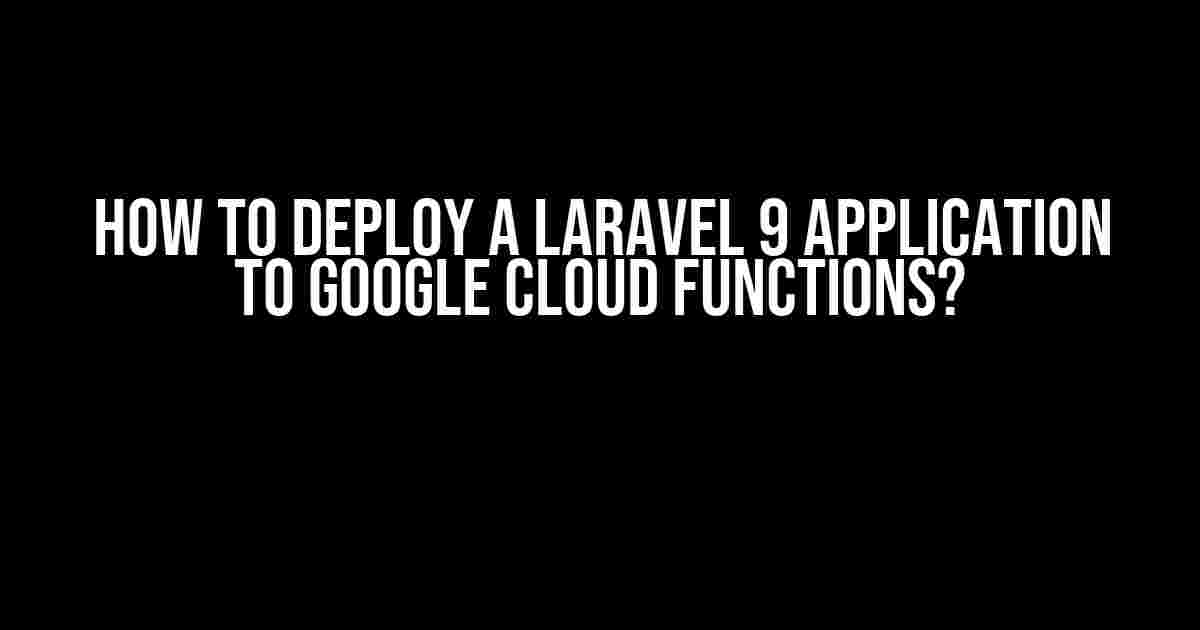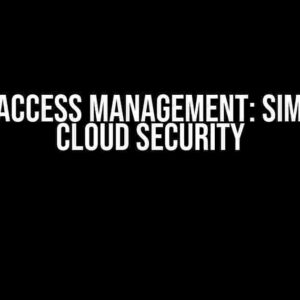Welcome to this comprehensive guide on deploying a Laravel 9 application to Google Cloud Functions! In this article, we’ll take you through the step-by-step process of deploying your Laravel 9 application to Google Cloud Functions, a serverless computing platform that allows you to run small code snippets without worrying about the underlying infrastructure.
Why Google Cloud Functions?
Before we dive into the deployment process, let’s take a quick look at why you should consider using Google Cloud Functions for your Laravel 9 application:
- Serverless Computing: Google Cloud Functions allows you to focus on writing code without worrying about the underlying infrastructure.
- Scalability: Google Cloud Functions can automatically scale to handle changes in workload, ensuring your application remains responsive and efficient.
- Cost-Effective: You only pay for the compute time consumed by your code, making it a cost-effective solution for small to medium-sized applications.
- Integration with Google Cloud Services: Google Cloud Functions seamlessly integrates with other Google Cloud services, such as Cloud Storage, Cloud Datastore, and more.
Prerequisites
Before we begin, make sure you have the following prerequisites in place:
- Laravel 9 installed on your local machine.
- A Google Cloud account with the Cloud Functions API enabled.
- The Google Cloud CLI installed on your local machine.
- A basic understanding of Laravel 9 and PHP.
Step 1: Prepare Your Laravel 9 Application
In this step, we’ll prepare our Laravel 9 application for deployment to Google Cloud Functions:
1.1 Create a New Laravel 9 Project
Create a new Laravel 9 project using the following command:
composer create-project --prefer-dist laravel/laravel project-name1.2 Install the Required Packages
Install the required packages for Google Cloud Functions using the following command:
composer require google/cloud-functions-framework1.3 Configure the Laravel 9 Application
Update the `config/cloud.php` file to include the following configuration:
<?php
return [
'functions-framework' => [
'version' => '1',
'runtime' => 'php74',
],
];
Step 2: Create a Google Cloud Function
In this step, we’ll create a new Google Cloud Function using the Google Cloud CLI:
2.1 Create a New Cloud Function
Create a new Cloud Function using the following command:
gcloud functions create function-name --runtime php74 --trigger-http --region us-central12.2 Configure the Cloud Function
Update the `function.yaml` file to include the following configuration:
functions:
function-name:
handler: LaravelFunctionsHandler
runtime: php74
environmentVariables:
LARAVEL_ENV: production
APP_KEY: your-app-key
DATABASE_URL: your-database-url
triggers:
- http
Step 3: Deploy the Laravel 9 Application
In this step, we’ll deploy our Laravel 9 application to the Cloud Function:
3.1 Build the Application
Build the Laravel 9 application using the following command:
composer build3.2 Deploy the Application
Deploy the application to the Cloud Function using the following command:
gcloud functions deploy function-name --source=. --runtime php74Step 4: Test the Deployment
In this step, we’ll test our deployment to ensure everything is working as expected:
4.1 Test the Cloud Function
Test the Cloud Function using the following command:
gcloud functions describe function-name --region us-central14.2 Test the Laravel 9 Application
Test the Laravel 9 application by accessing the Cloud Function URL in your web browser:
https://REGION-FUNCTIONS_PROJECT_ID.cloudfunctions.net/function-nameReplace `REGION`, `FUNCTIONS_PROJECT_ID`, and `function-name` with your actual values.
Conclusion
That’s it! You’ve successfully deployed your Laravel 9 application to Google Cloud Functions. In this article, we’ve covered the step-by-step process of deploying a Laravel 9 application to Google Cloud Functions, including preparing the application, creating a Cloud Function, and deploying the application.
Remember to update your `composer.json` file to include the required packages, configure your Laravel 9 application, and test your deployment to ensure everything is working as expected.
Happy deploying!
| Step | Description |
|---|---|
| 1 | Prepare the Laravel 9 application |
| 2 | Create a new Google Cloud Function |
| 3 | Deploy the Laravel 9 application |
| 4 | Test the deployment |
If you have any questions or need further assistance, please don’t hesitate to ask. Happy coding!
Here are 5 Questions and Answers about “How to deploy a Laravel 9 application to Google Cloud Functions?”
Frequently Asked Question
Deploying a Laravel 9 application to Google Cloud Functions can seem daunting, but don’t worry, we’ve got you covered! Here are some frequently asked questions to help you get started.
What are the prerequisites for deploying a Laravel 9 application to Google Cloud Functions?
Before you start, make sure you have a Google Cloud account, a Laravel 9 project set up, and the Cloud SDK installed on your machine. You’ll also need to enable the Cloud Functions API and create a new Cloud Functions project. Finally, install the `google/cloud-functions-framework` package in your Laravel project using Composer.
How do I package my Laravel 9 application for deployment to Google Cloud Functions?
To package your Laravel 9 application, you’ll need to create a `function` directory in your project root and add a `index.php` file that will serve as the entry point for your Cloud Function. You’ll also need to create a `composer.json` file that specifies the dependencies required by your application. Finally, run the command `composer install –optimize-autoloader –no-dev` to create a `vendor` directory.
How do I deploy my packaged Laravel 9 application to Google Cloud Functions?
To deploy your application, navigate to the `function` directory and run the command `gcloud functions deploy
How do I handle HTTP requests in my Laravel 9 application on Google Cloud Functions?
To handle HTTP requests, create a new `Http` directory in your `function` directory and add a `Request.php` file that will handle incoming requests. You can use the `Illuminate\Http\Request` class to handle requests and return responses. You’ll also need to update your `index.php` file to route requests to your `Request` class.
How do I configure environment variables for my Laravel 9 application on Google Cloud Functions?
To configure environment variables, create a `runtimeconfig.json` file in your `function` directory and add your environment variables as key-value pairs. You can then access these variables in your Laravel application using the `$_SERVER` superglobal or the `env` helper function.


